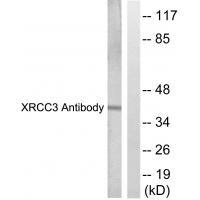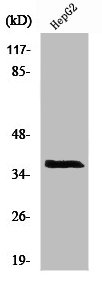![XRCC3(10F1/6), CF647 conjugate, 0.1mg/mL [26628-22-8] XRCC3(10F1/6), CF647 conjugate, 0.1mg/mL [26628-22-8]](https://biotium.com/wp-content/uploads/2021/02/view_image-195.jpeg)
XRCC3(10F1/6), CF647 conjugate, 0.1mg/mL [26628-22-8]
BNC472842
TargetXRCC3
Product group Antibodies
Overview
- SupplierBiotium
- Product NameXRCC3(10F1/6), CF647 conjugate, 0.1mg/mL
- Delivery Days Customer9
- CertificationResearch Use Only
- ClonalityMonoclonal
- Clone ID10F1/6
- Concentration0.1 mg/ml
- ConjugateOther Conjugate
- Gene ID7517
- Target nameXRCC3
- Target descriptionX-ray repair cross complementing 3
- Target synonymsCMM6; DNA repair protein XRCC3; X-ray repair complementing defective repair in Chinese hamster cells 3; X-ray repair cross-complementing protein 3
- HostMouse
- IsotypeIgG1
- Protein IDO43542
- Protein NameDNA repair protein XRCC3
- Scientific DescriptionThe x-ray repair cross-complementing (XRCC) proteins are responsible for efficiently repairing and maintaining genetic stability following DNA base damage. These genes share sequence similarity with the yeast DNA repair protein Rad51. XRCC1 is a protein that facilitates the DNA base excision repair pathway by interacting with DNA ligase III and DNA polymerase to repair DNA single-strand breaks. XRCC2 and XRCC3 are both involved in maintaining chromosome stability during cell division. XRCC2 is required for efficient repair of DNA double-strand breaks by homologous recombination between sister chromatids, and XRCC3 interacts directly with Rad51 to cooperate with Rad51 during recombinational repair. XRCC4 is an accessory factor of DNA Ligase IV that preferentially binds DNA with nicks or broken ends. XRCC4 binds to DNA Ligase IV and enhances its joining activity, and it is also involved in V(D)J recombination. Any defect in one of the known components of the DNA repair/V(D)J recombination machinery (Ku-70, Ku-80, DNA-PKCS, XRCC4 and DNA Ligase IV) leads to abortion of the V(D)J rearrangement process and early block in both T and B cell maturation. Primary antibodies are available purified, or with a selection of fluorescent CF® Dyes and other labels. CF® Dyes offer exceptional brightness and photostability. Note: Conjugates of blue fluorescent dyes like CF®405S and CF®405M are not recommended for detecting low abundance targets, because blue dyes have lower fluorescence and can give higher non-specific background than other dye colors.
- SourceAnimal
- Storage Instruction2°C to 8°C
- UNSPSC12352203







